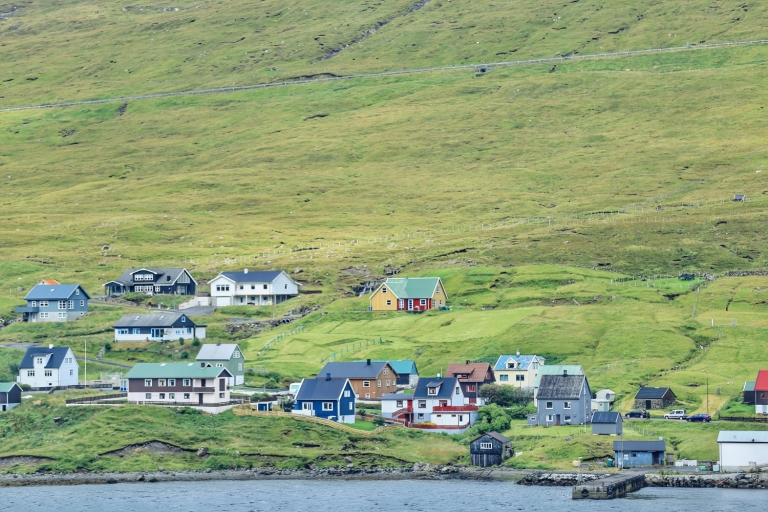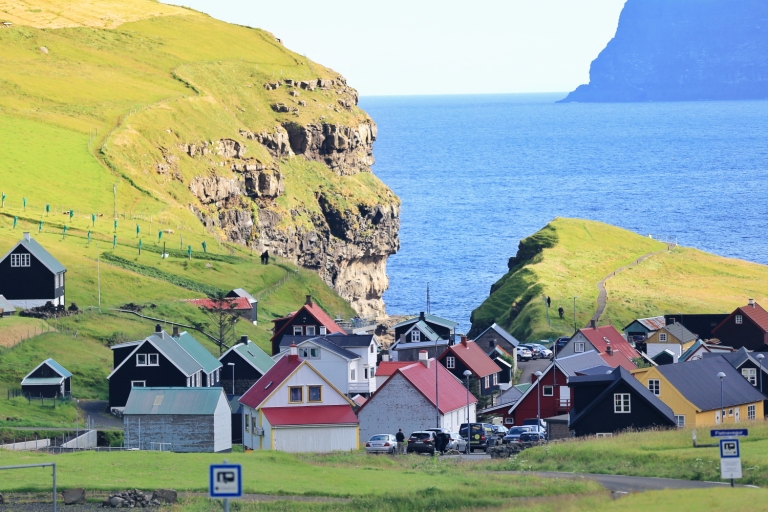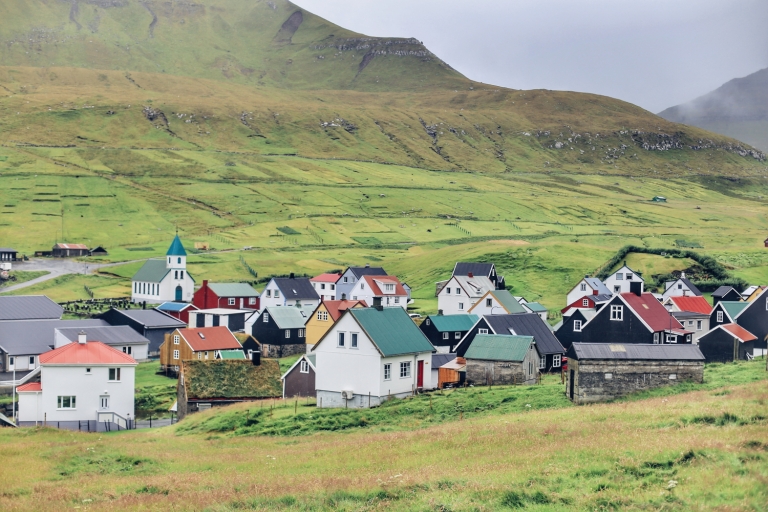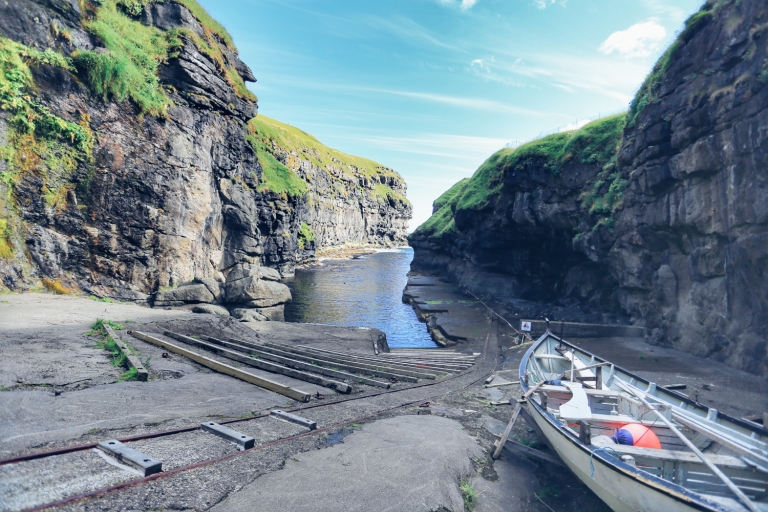RO: Cert e că oricât de mediatizate, filmate, pozate și postate pe social media ar fi Insulele Feroe, rămân acele insule mistice din mijloc de Atlantic de Nord, singuratice și izolate de haosul altor destinații europene, un arhipelag micuț de 18 insule care mai de care mai spectaculoasă și mai impresionantă când vine vorba de peisaje și natură. Prinse la mijloc între vecinele Islanda, Norvegia și Marea Britanie, par că au împrumutat câte un pic din fiecare. Peisaje robuste, complet neșlefuite, terenuri pietruite, o linie de coastă dramatică, cu stânci abrupte, cascade fascinante și fiorduri înguste. Parcă nu-ți vine a crede că niște insule atât de sterpe, unde nu crește nativ niciun copac (nu că vecina Islanda ar sta mai bine la acest capitol :D) sau unde cel mai înalt vârf nu depășește 900 de metri înălțime, pot fi atât de impresionante și ofertante când vine vorba de peisaje. Dar când ai mare la maximum 5 km distanță, oriunde te-ai afla pe insule, când ai parte de ierni blânde și veri răcoroase, când casele au acoperișuri de iarbă și când liniștea pare să fie fix la ea acasă, insulele Feroe chiar par desprinse dintr-o bucățică de Rai… danez 😀 Pentru că da, Insulele Feroe aparțin din punct de vedere politic Danemarcei însă din 1948 sunt autonome, fiind “acasă” pentru aproape 50.000 de locuitori (și 70.000 de oi, că doar nu degeaba o fi acesta Ținutul Oilor), având propriul său parlament, propriul steag și tadaaaaam, propria limbă, feroeza, un fel de islandeză la fel de neplăcută auzului 😀
EN: No matter how well publicized, filmed, photographed or posted on social media the Faroe Islands might be, they are still those mystic islands in the middle of North Atlantic ocean, lonely and isolated from the chaos of other European destination, a tiny archipelago of 18 spectacular and impressive islands, especially when it comes to landscapes and nature. Caught between the neighboring Iceland, Norway and Great Britain, they seem to have borrowed a bit of something from each one of them. Robust landscape, completely rugged, rocky terrain, a dramatic coast line, with sharp cliffs, fascinating waterfalls and narrows fjords. You can hardly believe that such barren islands, where no native tree exists (not that Iceland would be better at this chapter :D) or where the highest mountains does not exceed 900 meters height, can be so impressive and rewarding in terms of beautiful landscapes. But when you have the sea at maximum 5 km away no matter where you are on the islands, when there are mild winters and chilly summers, when houses have grass rooftops and when silence seems to be at home here, oh well… the Faroe Islands do seem like a little piece of… Danish Heaven 😀 Because yes, the Faroe Islands belong to Denmark from a political point of view, but since 1948 they are self-governed territory, because “home” for almost 50.000 people (and 70.000 sheep, no wonder this is the Land of Sheep), with their own parliament, own flag and tadaaaam, their own language, Faroese, a kind of Icelandic equally unpleasant to hear 😀


RO: Bun, dar despre insula Eysturoy vrem să vorbim astăzi, cea de-a doua cea mai mare insulă din arhipelag, conectată de principala insulă, Streymoy, prin podul Streymin, pe care feroezii îl marketizează tare mândri că fiind singurul pod construit peste oceanul Atlantic de Nord 🙂 Și-n plus față de asta, Eysturoy are cu ce se lăuda în materie de relief, pentru că aici se întâlnește cel mai înalt vârf muntos din întregul arhipelag feroez. Nu o avea el cine știe ce înălțime amețitoare la cei doar 882 de metri, însă din vârful Slættaratindur (Vârful Plat dacă ar fi să folosim traducerea cu tentă de oximoron :D) se pot vedea niște priveliști de-a dreptul spectaculoase, uneori chiar înspre vecina Islanda, cu al său ghețar Vatnajokull. Asta dacă bineînțeles, nu e întreaga vale acoperită de un strat gros de ceață de-l poți tăia cu cuțitul 🙂 Sunt două trasee de urcat până în vârf, unul mai lung (cu pornire din Gjogv, 4 ore) și altul mai scurt, de numai o oră, cu pornire din Eidi, însă din păcate noi nu am apucat să urcăm (ce-i drept, nici n-am fost norocoși de vreme prea bună). Iar de-o parte și de alta a Vârfului Plat se află două dintre cele mai frumoase sate de pe insulă. Unul dintre ele este Eidi, iar celălalt, de departe preferatul nostru, Gjogv 🙂
EN: Ok but we want to talk about Eysturoy island today, the second largest island in the archipelago, connected by the main island, Streymoy, via the Streymin Bridge, which the Faroese people like to advertise it like the only bridge built over the North Atlantic ocean 🙂 Besides this, Eysturoy has plenty of reasons to praise, because it has the tallest mountain peak in the archipelago. Not a stunning height at its only 882m, but from Slættaratindur Peak (The Flat Summit if we were to use the translation with a shade of oxymoron :D) there can be seen pretty amazing views, sometimes even to the neighboring Iceland, with its famous Vatnajokull glacier. That of course, if the entire valley is not covered by a thick layer of fog 🙂 There are two tracks for hiking to the top of the mountain, a longer one starting from Gjogv and lasting 4 hours, and a shorter one, one hour only, starting from Eidi, but unfortunately we could not do any of them (as the weather was not good at all). On both sides of the Flat Summit we have two of the prettiest villages on the island. One of them is Eidi, and the other one, our favourite by far, Gjogv 🙂



RO: Gjogv este unul dintre cele mai renumite sate din Feroe și pe bună dreptate că nu ar trebui ratat. Pe lângă căsuțele colorate, deseori acoperite de iarbă, satul este renumit pentru micul canion natural din centrul satului (de altfel denumirea satului înseamnă canion în traducere), pentru priveliștea bestială și bineînțeles, ca multe alte sate din arhipelag, pentru pescuit. Nu degeaba e pescuitul principala industrie în Feroe, asigurând peste 97% din exporturi (turismul este abia a doua).
EN: Gjogv is one of the most renowned villages in the Faroe and is totally worth a visit. Besides the colorful houses, often covered by grass, the village is well known for the small natural gorge from the center of the village (as a matter of fact the name of thevillage means gorge in translation), for its amazing views and of course, as many other villages in the archipelago, for fishing. That explains why fishing is the main industry in the Faroes, ensuring over 97% of the exports (the second one is tourism).











RO: E imposibil să vorbești despre insulele Feroe în numai câteva cuvinte. Doar mentionandu-le numele ne vin avalanșă detaliile despre micuțul arhipelag, atât de necunoscut și neexplorat de picioarele turiștilor. Sunt multe de povestit, pentru că insulele nu sunt doar despre fotbal ori despre vânătoarea sinistră de balene. Sunt ținutul oilor, al peisajelor spectaculoase, locul unde izolarea chiar îți pare exotică, unde ai câteva sate răsfirate pe ici pe colo și-n rest… o mare de pustietate, unde vântul și ceața sunt la ele acasă – un pic de dramă never killed nobody 😀 Păi nu spun ei feroezii să nu te superi vreodată ca n-ai noroc de vreme bună, ba dimpotrivă, să aștepți cinci minute, pentru că negreșit vremea se va schimba la 180 de grade. Ținutul pufinilor drăgălași (îndeosebi pe insula Mykines, unde noi din păcate nu am reușit să ajungem), al celei mai mici capitale (Torshavn cel fără de Mcdonalds-uri, fast food-uri și semafoare-deși sunt totuși trei în tot orașul), țara unde n-ai închisori și unde oamenii locuiesc că niște micuți hobiți în case cu acoperiș de iarbă. 18 insule care alcătuiesc o națiune, interconectate prin poduri, tuneluri, unele dintre ele subacvatice, drumuri care mai de care mai spectaculoase și mai sinuoase ori zboruri cu elicopterul mai ieftine ca un sandvici. E-adevărat, insulele Feroe chiar sunt cel mai bine păstrat secret al Europei.
EN: It is impossible to talk abiut the Faroe Islands in just a few words. Just mentioning their name we think about so many details about this tiny archipelago, so unknown and unexplored by tourists. There’s a lot to tell because the islands are not just about football or the terrifying wale hunt. This is the land of sheep, of spectacular landscape, the place where isolation really does seem exotic, where there are only a couple of scattered villages here and there… besides this, a huge wilderness, where wind and fog are at home – a bit of drama never killed nobody 😀 Well the Faroese people have a saying about the bad weather that always changes within 5 minutes. The land of cute puffins (especially on Mykines island, where unfortunately we could not go), the land of the smallest capital (Torshavn, the town without McDonald’s, fast foods and traffic lights – although there are three in the entire town), the country where there are no prisons and where people live like small hobbits in turf houses. 18 islands that form a nation, interconnected by bridges, tunnels, some of them underwater, spectacular and sinuous roads or helicopter flights that are cheaper than a sandwich. Indeed, the Faroe Islands are Europe’s best kept secret!
